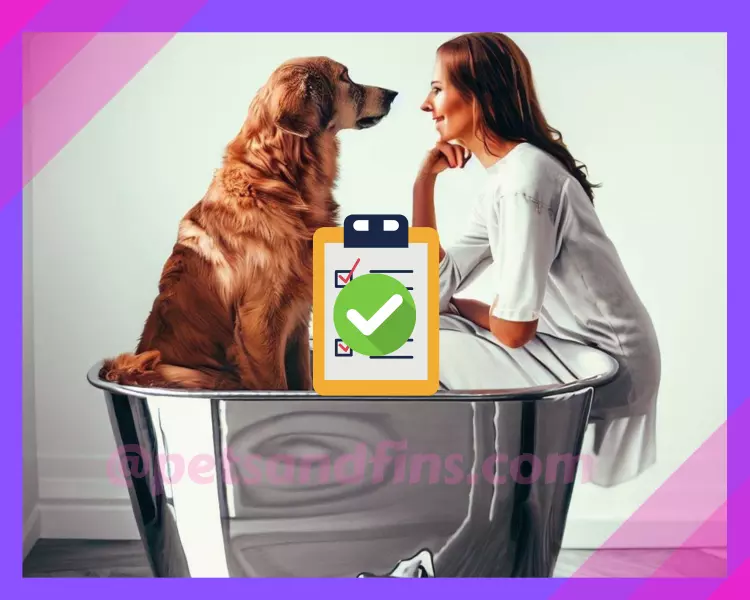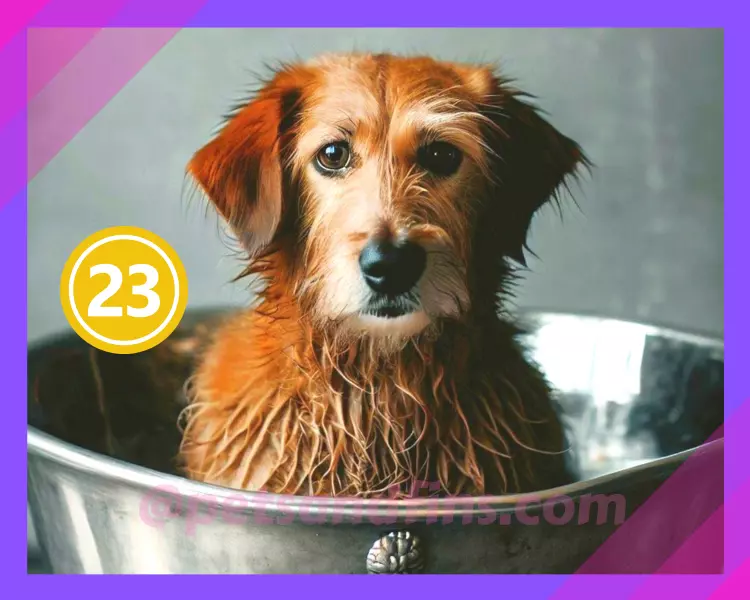As a dog owner, you know that bath time can be a struggle, especially if your furry friend hates water. So, “How to bathe a dog who hates water”? Keeping your dog clean and healthy is important for their overall well-being. What can you do to make bath time less stressful for both you and your dog?” In this article, I will provide 23 tips on how to bathe a dog who hates water.
My Personal Reason To Write This Article

My experience with my Shih Tzu Miko has been quite interesting when it comes to bath time. Initially, whenever I brought out the bath towel, Miko would run away to hide, making it clear that she was not fond of the idea of getting a bath. This made me research “how to bathe a dog who hates water?”
After a while, I noticed a significant change in her behavior. She no longer ran away at the sight of the towel, and in fact, seemed to enjoy the experience. After each bath, Miko would show herself off, wagging her tail with pride and excitement, as if to say, “Look how clean and fresh I am!”
This change in behavior occurred due to the fact that I made bath time a more positive experience for her, using treats and praise to reward good behavior. I am now delighted that Miko now enjoys bath time and that we are able to bond over this shared experience. Hence this article.
8 Prechecks Before Bathing A Dog That Hates Water

1.Check The Water Temperature
If you have a dog or pup who hates water, it’s essential to make the experience as comfortable as possible. One way to do this is by checking the water temperature before bathing them.
Just like us humans, dogs can get burned or chilled if the water is too hot or cold. By taking a few extra seconds to test the temperature, you can ensure your dog feels safe and secure during their bath. So next time you’re getting ready to bathe your furry friend, remember to check that water temperature first!
2.Towel
If you’re a dog owner, you know that bath time can be a bit of a challenge. But before you start the process, make sure to check if you have a towel handy!
Not only will it help dry your dog off after the bath, but it can also prevent the dog from shivering while waiting for the towel to be brought. The avoidance of this discomfort can actually make your dog enjoy the bath. So next time you’re getting ready to give your pooch a bath, remember to grab that trusty towel. Your furry friend will thank you for it!
3.Shampoo
If you’re like me, you know how important it is to keep your furry friend clean and smelling fresh. Well, before you start make sure you have a shampoo. Check the expiry date. Check the quantity. Is there enough shampoo for a bath. Mainly. Is it handy.
Is there a place where you can keep the shampoo handy to reach for it quickly. In my experience keeping a bowl is helpful so that you can pour the shampoo in the bowl and scoop it quickly.
4. Apron
Let’s face it. Your dog hates water and yet he needs a bath. He is going to shake that water off a lot. That’s why I’m here to remind you to always check if you have an apron before bathing your dog.
Why, you ask? Well, not only will it protect your clothes from getting soaked and dirty, but it will also make the whole process much easier for both you and your pet. You can comfortably bond with your furry friend while keeping yourself clean and dry.
5. Skid Free Mat
Have you ever had a slippery mishap while washing your pup? It can be dangerous for both you and your dog! That’s why I highly recommend checking if you have a skid-free mat before bathing your dog.
These mats provide traction and prevent slipping, making bath time safer and more enjoyable for everyone involved. Plus, they’re affordable and easy to find at most pet stores or online retailers.
6. Treats
Before you start the bathing process, make sure to check if you have some dog treats on hand.
Giving your dog a treat during or after their bath can help them associate the experience with something positive and rewarding. Plus, it can also distract them from any discomfort they may feel during the bath.
7. Massage Glove
Before you start the bath, make sure to check if you have a massage glove handy. Not only will it make the bathing experience more enjoyable for your pup, but it will also make your life easier.
The rubber bristles on the glove help to remove dirt and loose hair while providing a gentle massage for your dog’s skin. So next time you’re getting ready to give your pup a bath, don’t forget to grab that trusty massage glove!
8. Toys
Have you ever thought about checking for toys before giving your dog a bath? It may seem like a small detail, but it can make a big difference in your dog’s bathing experience. Toys can make the bath enjoyable for your dog. Provide a distraction to the dog and reduce anxiety.
23 Tips On How To Bathe A Dog Who Hates Water?

1.Secure & Safe Environment
Creating a secure and safe environment is crucial for dogs, especially for those who harbor a deep dislike for water. Speak gently to your dog and make your dog trust you in the process of bathing.
By establishing an environment that fosters a sense of security, you can gradually help your dog overcome their aversion and develop a more positive association with water.
Patience is the key, as forcing them into a water-related situation may further exacerbate their fear. Remember, each dog is unique, so understanding their individual needs and boundaries is essential for creating an environment where they feel safe to explore and conquer their fears.
2.Anti – Skid Mat
Dogs can not only resist getting wet, but they also tend to slip and slide around in the tub, making it difficult to keep them safe and secure. That’s why I highly recommend providing an anti-skid mat when bathing your furry friend.
An anti-skid mat is a simple solution that can make a big difference in your dog’s bath time experience. It provides traction for their paws, preventing slips and falls that could lead to injury or trauma.
Additionally, it helps your dog feel more secure and stable while standing in the tub.
By using an anti-skid mat during bath time, you’ll not only make the process safer for your pet but also easier for yourself. You won’t have to worry about holding onto them as tightly or struggling to keep them in one place.
3.Reassurance
For dogs who harbor a strong dislike for water and have had negative prior experiences, speaking reassuringly to them before starting the bathing process is essential. Dogs are highly intuitive creatures and can pick up on our emotions, so by speaking in a calm and soothing tone, you can help your dog feel more at ease.
Let your dog know that they are safe, and that you are there to support them through the bathing process. Take things slowly and steadily, being mindful of your dog’s body language and reactions throughout.
4.Positive Voice Intonation
It can be a frustrating and stressful experience for both you and your furry friend when your dog hates water. However, did you know that your positive voice can make all the difference?
When attempting to bathe your dog, it’s important to remain calm and use an cool tone of voice. Dogs are highly attuned to their owner’s emotions and can pick up on any negative energy or anxiety.
By using a friendly tone, you can help reassure your dog that everything is okay and create a more relaxed environment.
5.Giving Them A Treat
Giving your dog a treat when trying to bathe them can be an effective way to encourage them to associate water with positive experiences. By offering treats during the bathing process, you can help to create a more positive association with water.
Use treats as a reward for good behavior and offer them consistently throughout the bathing process. Treats can also serve as a distraction from any potential fears or anxieties your dog may be experiencing, allowing them to focus on something positive instead.
Remember, every dog is different, so it’s important to understand your dog’s individual needs and preferences. Also reward the dog with a treat only if the dog co-operates. Otherwise, the dog may misunderstand the purpose of the reward which will make things worse.
6.Turn On The Water Slowly
There is one simple trick that can make the process much easier: try switching on the water slowly.
By turning on the water slowly, your dog will have time to adjust to the sound and temperature of the water. This can help them feel more comfortable and less anxious during bath time. Additionally, it can prevent them from getting scared and jumping out of the tub or shower.
7.Reduced Water Flow
Reducing the water flow can make the experience much more comfortable for them. Dogs have sensitive skin, and high-pressure water can cause discomfort and anxiety.
By reducing the water flow, we can help our dogs feel more relaxed during bath time. It also allows us to control the amount of water that gets on their face and ears, which are areas that most dogs dislike being wet. Using a handheld showerhead with adjustable pressure settings is an excellent way to achieve this.
Moreover, reducing the water flow will also conserve water and save money on your utility bill. As responsible pet owners, it’s essential to find ways to reduce our environmental impact while still taking care of our pets’ needs.
8.Not Too Noisy
Loud noises and sudden movements can easily startle your dog and make them feel even more anxious and stressed. Therefore, it’s best to keep the entire environment as quiet and serene as possible. Consider turning off any background music or loud appliances and minimize any potential distractions. Additionally, avoid using any harsh or sudden movements when handling your dog, as this can also contribute to their anxiety.
9.Start From The Legs
By starting with the legs, you can help your dog get used to the sensation of being wet without overwhelming them. Gradually work your way up their body and use positive reinforcement techniques like treats and praise to keep them calm and happy.
Not only will this method make bath time less stressful for both you and your dog, but it can also prevent injuries. If you try to force a scared or resistant dog into a full bath all at once, they may panic and injure themselves trying to escape.
10.Do Not Force Bathe
Forcing your dog to bathe is never a good idea and can actually make their dislike of bathing even worse. When a dog is scared or anxious, their natural response is to resist and fight back, so trying to force them into a situation they are uncomfortable with can be incredibly traumatic for them.
This can lead to even more negative associations with bathing, making future attempts even more challenging. Instead of forcing your dog to bathe, try to work with them at their own pace. Start by introducing them to the water in a controlled and gentle manner,
11.Massage The Shampoo
Massage the shampoo into their fur.
Massaging your dog during bath time not only helps to distribute the shampoo evenly but also creates a relaxing and enjoyable experience for them. The gentle pressure of your hands on their body can help to calm their nerves and reduce anxiety associated with water.
Moreover, massaging your dog during bath time can also improve their overall health by increasing blood circulation, promoting healthy skin, and reducing muscle tension.
12.Go Gentle On The Face
When bathing a dog who hates water, it’s important to be extra gentle, especially around their face and sensitive areas. So being gentle and mindful during the bathing process can help make it a more pleasurable experience for them.
Avoid getting water or soap in their eyes or ears, as this can be uncomfortable and potentially harmful. Use a damp cloth to wipe their face and sensitive areas, being careful not to apply too much pressure.
By being mindful of your dog’s comfort and safety, you can help them to feel more relaxed and at ease, ultimately making the bathing process more enjoyable for both you and your furry friend.
13.Dry Well And Slowly
One thing that is crucial when bathing your furry friend is to dry them well. Keeping your dog wet for too long after bath can lead to a bad bath experience.
When dogs are wet, they are more likely to get cold and uncomfortable. This can cause them to become agitated and anxious, making them dislike bath.
Use a towel or blow dryer on low heat to remove as much moisture as possible. You may also want to consider using a special drying tool designed specifically for dogs.
14.Long Walk Before Bath
Taking your dog on a long walk before attempting to bathe them can be a great way to help them feel more relaxed and comfortable during the bathing process. Exercise helps to release endorphins in the brain, which can have a calming effect on your dog’s mood and overall temperament.
By taking your dog for a walk before bathing them, you can help to burn off excess energy and reduce any stress or anxiety they may be feeling. This can ultimately make the bathing process more enjoyable for them because they may enjoy the relaxing bath.
15.Acclimatize The Bathing Area
With a little bit of patience and some acclimatization, you can make the experience much more pleasant for both you and your furry friend.
The first step is to start slowly. Begin by introducing your dog to the bathing area without actually getting them wet.
Let them sniff around and get comfortable with the space. Once they seem at ease, try giving them treats or toys while they are in the area to create positive associations.
Next, gradually introduce water into the equation. Start by using a damp cloth to wipe down their fur, then move on to using a spray bottle or cup of water to wet them down.
16.Stay In The Bath-Tub Without Water
If your dog has a strong aversion to water and bathing, it may be helpful to start by introducing them to the bathtub gradually, without any water. This can help your dog become more comfortable with the environment and reduce their anxiety around the bathing process.
Allow your dog to explore the space at their own pace, being sure to supervise them to ensure their safety. Over time, gradually increase the amount of time your dog spends in the bathtub, always using positive reinforcement to encourage good behavior.
By taking a slow and gradual approach to introducing your dog to the bathtub, you can help them feel more at ease and reduce their fear and anxiety around the bathing process.
17.Brush Your Dog In The Bathing Area
Brush your dog in the bathing area before attempting to bathe them.
By brushing your dog’s coat before getting them wet, you will remove any tangles or mats that may become worse during the washing process. This will not only make it easier to wash their fur but also prevent any discomfort or pain caused by pulling on matted fur.
Additionally, brushing your dog in the bathing area can help them become more comfortable with the space and reduce their anxiety about being bathed. By associating positive experiences with the area, they may become more willing to enter it willingly in the future.
18.Try Bathing Indoors
f you’re trying to bathe a dog that hates water, it’s a good idea to do so indoors. This way, you can control the environment and reduce any external stressors that might make the experience even more difficult for your furry friend.
An indoor space provides a calm and quiet atmosphere, free from distractions and loud noises that might cause your dog to become more anxious.
19.Mild Smelling Shampoo
Using a mild shampoo can make the experience much more pleasant for both you and your pup.
Mild shampoos are formulated with gentle ingredients that won’t irritate your dog’s skin or eyes. They also have a milder scent, which is less overwhelming for dogs with sensitive noses. By using a mild shampoo, you can help reduce any discomfort or anxiety your dog may feel during bath time.
Additionally, using a mild shampoo can help maintain your dog’s coat and skin health. Harsh shampoos can strip away natural oils and cause dryness and irritation. A mild shampoo will clean your dog’s coat without causing any damage.
20.Try Avoiding The Shower-Head
One tip is to avoid using the showerhead when bathing your dog. The sound of running water can be intimidating for some dogs, and the pressure from the showerhead can be uncomfortable or even painful. Instead, try using a handheld sprayer or a bucket of water with a cup to pour over your dog.
By avoiding the showerhead, you’ll create a more calming environment for your pet and make bath time less traumatic. Plus, it’s an opportunity to bond with your dog by giving them treats and praise throughout the process.
21.Try Altering The Shower-Head Force
When trying to bathe a dog that hates water, it’s important to consider the force of the water you’re using. Shower-heads that use pressure pumps can be particularly uncomfortable or even painful for dogs, causing them to become even more fearful of the bathing process.
Instead, try using a gentle stream of water that won’t be too harsh on your dog’s skin and fur. You can adjust the shower-head or use a bucket to pour water over your dog instead.
Remember to use lukewarm water to prevent any discomfort for your furry friend. By being mindful of the water pressure and temperature, you can help your dog feel more comfortable and relaxed during the bathing process.
22.Try A Grooming Professional
If you have tried everything to help your dog feel more comfortable during bath time, but nothing seems to work, it may be time to consider seeking help from a professional. Professional groomers have the expertise and experience to work with dogs that have a strong aversion to water and can help you identify the underlying cause of your dog’s fear.
They can also provide helpful tips and guidance on how to modify your dog’s behavior and reduce their anxiety around the bathing process. Some dogs may require more specialized care or medication to help them overcome their fear. By seeking the help of a professional, you can ensure that your dog receives the care and attention they need to feel safe and comfortable during bath time.
23. Try A Behavoir Specialist
Don’t give up hope just yet. One option to consider is contacting a behavior specialist for assistance. These professionals have experience working with dogs who have a range of behavioral issues, including fear of water or bathing.
They can provide personalized guidance and training techniques that are tailored to your specific dog’s needs and personality. With their help, you may be able to overcome your dog’s aversion to water and make bath time a more pleasant experience for everyone involved.
Remember, seeking help is a sign of strength and commitment to your pet’s well-being.
Pro Tips from My Personal Experience
1. Keep a protein bar handy for yourself, especially if you are diabetic or are likely to tire.
2. Keep a Towel for yourself to wipe your sweat off while bathing the dog.
Summary
In conclusion, bathing a dog who hates water can be a challenging task, but it’s not impossible. By preparing your dog for the experience, taking the right approach, and using positive reinforcement, you can help your furry friend overcome their fear of water and make bath time a more enjoyable experience for both you and your dog.
Remember to take things slow, be patient, and reward your dog for their good behavior. With a little bit of effort and some creative techniques, you can turn a stressful and unpleasant task into a fun and bonding experience with your furry companion.
You can also check out this link How to give a dog a bath without water? 7 ways you Must know (dogadvisorycouncil.com)
How To Give A Dog A Bath Without Water?

As a dog owner, you know that bathing your furry friend can be quite a challenge. Some dogs are afraid of water, while others just hate the whole process of getting wet and soapy. Fortunately, there are ways to bathe your dog without water that are easy and stress-free for both you and your pet.
The first step in keeping your dog clean is to brush them regularly. Brushing removes dirt, debris, and loose hair from their coat, preventing matting and tangling. Regular brushing also distributes natural oils throughout their fur, keeping it healthy and shiny.
Another option for bathing without water is to use dry shampoo. Dry shampoo comes in a powder or spray form that you apply directly to your dog’s coat. It absorbs excess oil and dirt, leaving their fur clean and fresh-smelling. Be sure to choose a dry shampoo specifically designed for dogs as human products can be harmful.
Wet bath wipes are another great alternative to traditional baths. These wipes come pre-moistened with gentle cleansers that remove dirt and odors from your dog’s coat without the need for water or rinsing. They’re perfect for quick cleanups after walks or playtime.
When using any of these methods, it’s important to avoid getting any product in your dog’s eyes or mouth. Always read the instructions carefully before using any new product on your pet.
In conclusion, bathing your dog doesn’t have to be a daunting task anymore! With regular brushing, dry shampoo, or wet bath wipes you can keep them clean without the hassle of traditional baths. Not only will this save time but also reduce stress on both you and your furry friend!
How To Bathe A Large Dog Who Hates Water?

As a dog owner, one of the most challenging tasks is to bathe a large dog who hates water. It can be a daunting and frustrating experience for both the owner and the dog.
However, with patience, persistence, and some helpful tips, you can make bath time an enjoyable experience for your furry friend.
Firstly, it’s essential to prepare everything you need before starting the bathing process. Gather all necessary supplies such as shampoo, towels, brush or comb, treats, and a non-slip mat.
Ensure that the water temperature is lukewarm because hot or cold water can cause discomfort to your pet.
You may need a leash or harness in case of a large dog to help you bathe the dog.
Secondly, introduce your dog to water gradually. Start by letting them explore the bathtub or shower area without any water in it. Allow them to sniff around and get comfortable with their surroundings.
Once they seem relaxed in this environment, turn on the faucet slowly so that they can hear the sound of running water but not feel overwhelmed by it.
Thirdly, use positive reinforcement techniques during bath time. Reward your dog with treats or praise when they behave well during bathing sessions. This will help them associate bath time with positive experiences rather than negative ones.
Fourthly, use a gentle touch when washing your dog’s body parts. Avoid getting soap in their eyes or ears as this can cause irritation or infection. Use a washcloth or sponge to clean sensitive areas such as their face and paws.
Finally, rinse thoroughly after shampooing to ensure that no soap residue remains on your pet’s skin which could cause itching or dryness later on.
My Dog Tries To Bite Me When I Give Him A Bath

As a dog owner, one of the most challenging tasks is giving your furry friend a bath. While some dogs may enjoy the experience, others may try to bite you or run away. If you’re struggling with this issue, don’t worry – you’re not alone. Many pet owners face this problem and wonder how to handle it.
Firstly, it’s essential to understand that dogs are creatures of habit and routine. They thrive on consistency and predictability in their daily lives. Therefore, if you only give your dog a bath once every few months, they may become anxious or fearful when it’s time for their next bath.
To overcome this issue, try to establish a regular bathing routine for your dog. This will help them become more comfortable with the process over time and reduce their anxiety levels. You can initially try familiarizing the dog to the bathing area.
Another reason why your dog might be trying to bite you during bath time is that they feel threatened or vulnerable. Dogs are naturally territorial animals and can become defensive when they feel like their personal space is being invaded.
To avoid triggering this response in your dog, make sure that the bathing area is calm and quiet. Avoid loud noises or sudden movements that could startle them. Additionally, consider using a non-slip mat in the bathtub or shower to provide extra stability for your furry friend.
If all else fails and your dog continues to try to bite you during baths despite these efforts, it might be worth seeking professional help from a certified animal behaviorist or trainer. They can work with you and your pet to identify any underlying issues causing this behavior and develop strategies for addressing them.
In conclusion, giving your dog a bath doesn’t have to be a stressful experience for either of you. By establishing a regular routine, creating a calm environment, and seeking professional help if necessary – both you and your furry friend can learn to enjoy bath time together!
My Dog Won’t Let Me Bathe Him

Sometimes, our dogs can be stubborn and refuse to cooperate during bath time. If you are struggling with this issue, don’t worry, you are not alone. Many dog owners face this problem and there are ways to overcome it.
Firstly, it is important to understand why your dog may be resisting bath time. Dogs have a strong sense of smell and they may find the scent of shampoo or soap overwhelming. Additionally, some dogs may have had negative experiences in the past during bath time which has led them to become fearful or anxious.
To help ease your dog’s anxiety towards bathing, start by introducing them to water gradually. Allow them to explore shallow water in a bathtub or kiddie pool before attempting a full bath. You can also use treats and positive reinforcement techniques such as praise and petting during these sessions.
Another tip is to make sure that the water temperature is comfortable for your dog. Dogs have sensitive skin so using lukewarm water will prevent any discomfort or irritation.
If your dog still refuses to cooperate during bath time despite these efforts, consider seeking professional help from a certified animal behaviorist or trainer who can work with you and your pet on overcoming this issue.
It is important not to force your dog into taking a bath as this can cause more stress and anxiety for both you and your furry friend. Instead, try using alternative methods such as dry shampoo or grooming wipes which can help keep their coat clean without the need for water.
In conclusion, bathing our dogs is an essential part of their hygiene routine but it doesn’t have to be a stressful experience for both parties involved.
How To Bathe A Dog At Home?

Regular bathing not only helps to remove dirt and odors but also keeps their coat shiny and healthy. While taking your dog to a professional groomer can be expensive, you can easily learn how to bathe your dog at home.
Firstly, before starting the bath, make sure that you have all the necessary supplies ready. You will need shampoo specifically designed for dogs, a bucket or hose for water, towels for drying, and a brush for grooming after the bath. It is also important to choose an appropriate location for bathing your dog – preferably outdoors or in a bathtub.
Next, start by brushing your dog’s coat thoroughly before getting them wet from the legs. This helps to remove any loose hair or mats in their fur. Once they are brushed out, wet them down with warm water using either a bucket or hose.
After wetting them down completely, apply the shampoo all over their body while avoiding their eyes and ears. Gently massage the shampoo into their fur until it lathers up nicely. Be sure to rinse off all of the shampoo thoroughly as leaving any residue can cause skin irritation.
Once they are rinsed off completely, use towels to dry them off as much as possible before letting them shake themselves dry outside. After they have shaken off most of the water from their coat, use another towel or two to finish drying them off completely.
Finally, after they are fully dried off and looking fluffy again – give them some extra love and attention! They deserve it after being such good sports during bath time!
